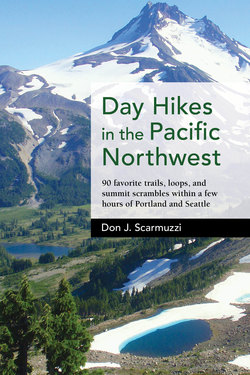Читать книгу Day Hikes in the Pacific Northwest - Don J. Scarmuzzi - Страница 5
ОглавлениеPREFACE
The superbly magnificent Pacific Northwest is forever an outdoor treasure of indescribable value. This guidebook covers the South Cascades in Washington through Oregon, including the North Coastal Range all the way to the Wallowas in the northeast part of the state. Simply put, Day Hikes in the Pacific Northwest is a day hiker’s dream in print. It’s written solely with the hiker in mind so jaunts are easily followed with colorful pictures and detailed maps. Concise directions with road conditions from Portland (or Seattle, in a few cases) to each trailhead are given (where online map services fail at times), along with what pass is needed to park at the trailhead or on the hike if any, and whether or not a restroom is present at the trailhead. For each hike, the mileage, compass directional, landmarks, and suggested routes for loops are described meticulously. Many people by habit hardly ever drive more than an hour or two from the house to the trailhead, but for that extra hour or so most avid hikers and locals have known for a long time their efforts are well rewarded! The hikes with drives longer than 4 hours are better enjoyed when camping or seeking accommodations near the trailheads.
For parking, many trailheads require a day use fee, which can be covered by a Northwest Forest Pass in Oregon or a Northwest Forest Pass or Discover Pass in Washington. Both passes are good for one day ($5 to around $12 per vehicle) or one year ($30 to $35) and are available online (www.fs.usda.gov/detail/r6/passes-permits/recreation/?cid=fsbdev2_027010, or discoverpass.wa.gov), at ranger stations, and at many retail outlets. It’s always helpful to look up your hike online for particulars on payment at the trailhead and to make sure trails are open. At times a trail may be inaccessible due to rock- or landslides, flooding, road closures, fires, snow, or for wildlife protection. I also highly recommend glancing over the hike before leaving home for vital info including what else to bring.
Each hike begins with essential information about elevation, distance, duration (includes short breaks), difficulty level, and trip reports that point out any noteworthy and important tidbits. Elevation information includes the highest point (or points) and destination of a hike as well as the maximum vertical gains you will experience along the trail. Difficulty level is broken up into five categories: easiest (short hike, little to no elevation change, sometimes paved, ideal for families and novices), moderate (brief hike, more elevation change but easier than most), strenuous (longer hike, some steeps, trail-locating, use of hands for balance possible), very challenging (fairly long hike, sustained steeps for thousands of feet, bushwhacking, scrambling, GPS device helpful, use of hands necessary), and expert only (very long hike, punishing steeps, overgrown paths, exposed cliffs, climbing-type moves possible though no climbing gear mandatory, traction devices at times, route-finding).
For the sake of brevity, I use the abbreviations TH (trailhead), FR (Forest Road), ft (feet), mi (mile), AWD (all-wheel drive/4WD). Likewise I refer to Pacific Crest Trail 2000 (also known as the Pacific Crest National Scenic Trail or Crest Trail) as the PCT. A switchback is a spot in a trail that zigzags sharply, whether once or fifty times. A shoulder is a rise or small ridge. “Exposure” refers to an individual’s level of risk of falling where a tumble would be fatal. A trail section described as “airy” is exposed to some degree, with drop-offs. Exercise extreme caution in such areas. “Gendarmes” refer to spiked pinnacles or spires blocking a ridgeline, borrowing its meaning from medieval French soldiers standing at guard. The maps are tracked correctly even when USGS trails are slightly off. Distances on the maps given are approximate but easy to follow.
Again, this is a hiking guidebook for hikers who love to hike! There are no token hikes or fluff sections about how to hike, who to bring, or how to make trail mix! We cut to the chase and get to the goods here! Presented with originality are many popular hikes and several you may have never heard of. Most have other options and loops within them as well, more than doubling the actual number of total hikes listed. Colorful topographic maps and pictures help tie in the text, making each hike perfectly straightforward to follow.
A dry, warm hiker is a happy hiker! Bring some if not all of the following on your day hike: your experience, a friend, lots of layers (synthetic or not) including backup rain gear and dry socks, sunscreen, water or purifier, food, flashlight or headlamp, map or GPS or compass, fresh batteries, smartphone backup battery/charger, first aid kit with an emergency blanket, lighters, knife, insect repellent, whistle—and a sense of humor.
